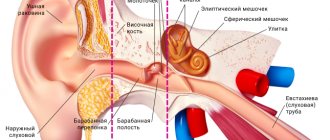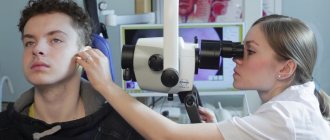Who among us has not experienced a feeling of confusion and helplessness when, for some reason, we could not hear the words of our interlocutor? Hearing loss is a serious detriment to a full life, because we receive the vast majority of information about the world around us through our ears. A healthy person is able to recognize over 400,000 different sounds. Hearing loss significantly reduces a person’s quality of life and complicates his speech communication.
In Russia today there are about 13 million people with poor hearing. 14% of the world's inhabitants over the age of 30 begin to experience these problems. After the age of 60, 30% of the adult population of the planet suffers from hearing loss.
1 Audiometry in MedicCity
2 Flushing the ear canals
3 Diagnosis of hearing loss in MedicCity
Degrees of hearing loss
Hearing loss refers to any weakening of hearing. There are 3 degrees of hearing loss:
- mild hearing loss (the hearing threshold rises to 40 decibels, speech differs at a distance of 4-6 meters);
- moderate hearing loss (hearing threshold from 41 to 50 decibels, a person perceives spoken language at a distance of 1 to 4 meters);
- severe hearing loss (hearing threshold up to 70 decibels, spoken speech can be heard from a distance of 1 meter).
Acute serous otitis media
This causes fluid to accumulate in the tympanic cavity (behind the eardrum). A person hears “as if through water.”
The cause of the occurrence is a long course of tubo-otitis.
Treatment
During the examination, the ENT doctor will see the clinical manifestations characteristic of this condition and, if necessary, will conduct further examination. To restore hearing, blowing of the auditory tubes according to Politzer is used; pneumomassage of the eardrums; gymnastics for the auditory tubes is prescribed; catheterization of the auditory tubes and, if necessary; medications. More serious treatment may be required, including hospitalization in the ENT department.
Sensorineural (sensorineural) hearing loss
Sensorineural ( sensorineural ) hearing loss is characterized by damage to sound-receiving organs and the death of hair cells that transform sounds into neuroelectric impulses.
The main symptom of sensorineural hearing loss is hearing loss. Often occurs after an acute respiratory viral infection, psycho-emotional stress, or intoxication. It can affect either one ear or both at the same time. A very common symptom of this disease is noise in the ear: it can be either high-frequency (ringing, squeaking, “buzzer,” “hissing”) or low-frequency (hum). Such phenomena require immediate medical attention. A doctor who suspects sensorineural hearing loss needs to perform tuning fork tests. To verify the diagnosis and accurately determine the degree of hearing loss, a hardware test is performed - pure tone threshold audiometry. Without treatment and prevention, the disease progresses and leads to complete deafness.
Clinical forms of sensorineural (sensorineural) hearing loss
Sudden hearing loss
Sudden hearing loss can produce symptoms of conductive, sensorineural and mixed hearing loss, depending on the cause. If hearing has been impaired as a result of exposure to noise, the person first loses the ability to hear sounds of certain frequencies (about 4000 Hz), and then becomes less and less able to distinguish sounds of all frequencies.
A person can lose their hearing suddenly over a period of hours or even minutes. As a rule, infection is to blame for hearing loss. Patients with this disorder compare their sensations to a broken telephone wire: a sudden onset of silence. As a rule, the disease of this form is unilateral. It is necessary to urgently consult a doctor. When assistance is provided in the first days of the disease, hearing can be restored in more than 90% of cases.
Acute hearing loss
A week has passed since the man lost his hearing. The probability of hearing returning at this stage is 70-90%. If the clinical picture persists for 1-3 months, then we can talk about subacute hearing loss.
With subacute hearing loss, a person feels fullness in the ears, which becomes permanent. Against the background of tinnitus, the patient begins to feel that he is beginning to hear worse and worse. Of course, the time to restore hearing has already been lost a little, but you still need to see a doctor. Otherwise, hearing loss may develop into a chronic form.
Chronic hearing loss
The duration of the disease is more than 3 months. It is characterized by the fact that even with existing hearing loss, a further decrease in hearing occurs, accompanied by tinnitus. Periods of hearing deterioration may alternate with periods of slight remission. The likelihood of complete hearing recovery at this stage is extremely low. However, courses of maintenance vascular therapy can prevent further hearing loss.
There is also senile hearing loss (presbycusis). related hearing loss is characterized by ringing in the ears and an inability to understand speech (ie, speech intelligibility).
1 Diagnosis of hearing loss in MedicCity
2 Diagnosis of hearing loss in MedicCity
3 Diagnosis of hearing loss in MedicCity
Hearing problems: symptoms
Signs of decreased sensitivity to sounds and decreased noise effect may appear gradually, although they can develop rapidly. With a sharp decrease in hearing, the prognosis is favorable; the main thing is to seek professional medical help in a timely manner. There are several signs of decreased ability to hear sounds. If you find yourself with at least one of them, you need to see an ENT doctor to have your hearing checked.
So, the prerequisites for the fact that your sensitivity to sounds is reduced are the following symptoms:
- you constantly have to ask again, and others around you have to repeat what was said several times;
- when there are several interlocutors with you, it is difficult for you to concentrate and you lose the thread of the conversation;
- you can’t help but feel that everyone around you is deliberately speaking in a quiet voice;
- it is difficult to carry on a conversation in a crowded and noisy place (for example, in the subway or cafe);
- with limited hearing, it becomes difficult to understand children’s speech;
- Watching TV shows starts by turning the TV volume up to full power;
- already on a subconscious level, a person with poor hearing has to mechanically watch the lips of the interlocutor so as not to make a mistake in what he heard;
- in moments of silence, it seems that there is noise or ringing in the ears.
Of course, such a condition leads a person to irritability, a constant feeling of anxiety and decreased self-esteem. If you understand that your hearing functions are being lost, do not hesitate and contact an ENT doctor to get competent, timely help and avoid complete hearing loss.
Conductive hearing loss
Conductive when the middle ear or eardrum is damaged as a result of mechanical trauma or infection.
Conductive hearing loss is a hearing impairment associated with poor perception of sounds, caused by dysfunction of sound conduction from the outer ear and eardrum to the middle ear and from it to the inner ear. That is why this type of hearing loss is called conductive – from the Latin word “to conduct”.
With conductive hearing loss, sound vibrations do not reach the main human receiving organ - the hairs of the epithelium of the organ of Corti located in the inner ear, which transmit signals to the auditory nerve.
Conductive hearing loss is characterized by reduced sensitivity in the perception of sounds, but there is no change in their clarity. It is enough to increase the volume and a patient with this form of hearing loss will hear normally. Typically, a person with conductive hearing loss speaks in a low voice and has normal ability to distinguish sounds, but has difficulty hearing when chewing.
Causes of conductive hearing loss
The causes of conductive hearing loss can be very diverse.
For example, it is often caused by wax plugs in the outer ear. Unfortunately, patients often try to get rid of such a traffic jam on their own, and often such amateur activity leads to serious injuries and inflammations, fraught with irreversible hearing loss.
Meanwhile, an experienced otolaryngologist at the MedicCity clinic can relieve you of cerumen impaction and the hearing loss it causes within a few minutes and without any discomfort.
Another common cause of conductive hearing loss is otitis externa, an inflammation in the outer ear, often accompanied by suppuration.
At the same time, attempts to treat otitis independently with the help of lotions and randomly selected medications can seriously aggravate the situation and dramatically complicate auditory perception, for a long time or even forever.
In addition, conductive hearing loss can be caused by the following eardrum-related causes:
- perforation or damage to the eardrum (may be accompanied by stabbing pain and bleeding);
- tympanosclerosis or sclerosis of the tympanic membrane is a pathological process of inflammation and degradation of the membrane tissue, accompanied by the formation of a purulent mass;
- anatomical anomalies of eardrum deformation.
These membrane conditions can be caused by injuries, thermal effects, infectious viral diseases, etc.
Sudden conductive hearing loss can also be caused by sudden changes in pressure on the eardrum, for example, when going underwater or into a mine, or when taking off on an airplane. In the middle ear, the consequences of acute and chronic otitis media - inflammation of the middle ear, as well as exudative otitis - can act as sound vibration blockers.
Finally, at the level of the inner ear, the causes of conductive hearing loss can be severe forms of otosclerosis and anatomical obstruction.
How our ear works
To understand why there is a decline in the ability to detect and understand sounds, let's look at how the elements of the ear system function.
The visible part of the ear, called the outer ear, is like a locator and detects sound vibrations created by a noise source. The sound then travels through the ear canal and reaches the eardrum. This, in turn, moves the auditory ossicles located in the middle part of the ear. The signal enters the inner part of the ear (cochlea), where it is converted into microimpulses and sent directly to the brain.
A decrease in hearing abilities may be associated with disruptions in the functioning of one or more elements of this chain.
Diagnosis and treatment of hearing loss
In the department of otorhinolaryngology of the multidisciplinary clinic "MedicCity" you will quickly and accurately be diagnosed using special diagnostic procedures and first-class equipment from the world's leading manufacturers.
A special study - audiometry - is aimed at determining the degree of hearing loss. This study also evaluates the effectiveness of treatment for hearing loss. Tuning fork tests and impedance measurements are also carried out .
1 Audiometry in MedicCity
2 Audiometry in MedicCity
3 Audiometry in MedicCity
Depending on the identified factors, one or another type of treatment is prescribed: conservative (taking anti-inflammatory drugs, physiotherapy - electrophoresis, phonophoresis, etc.), surgical (for example, removal of sclerotized tissue or correction of an anatomical defect).
Special procedures are used to clean the ear in case of suppuration, plugs, etc. A very common procedure for cleaning the auditory tube is by blowing it according to Politzer, using a special balloon.
We have also developed comprehensive treatment programs for sensorineural hearing loss.
Eardrum injury
There can be several causes of injury:
- blow to the ear area;
- perforation of the membrane by foreign objects (a cotton swab, a hairpin, a match, the core of a pen and other objects that are so convenient for scratching the ears);
- falling from a height, including into water;
- injury due to a sudden change in atmospheric pressure.
Treatment
During the examination, the ENT doctor will determine the fact of perforation of the eardrum, perform audiometry to exclude the development of auditory neuritis due to injury, and develop a plan for further action. In most cases, the tactic is wait-and-see. The membrane may close on its own. It is imperative to protect the ear from water and avoid air travel.
A month later, if the integrity of the eardrum has not been restored, the issue of myringoplasty (closing the defect of the eardrum surgically) is considered.
In what cases do hearing aids help?
A fairly common practice for restoring hearing in case of hearing loss is the use of an external hearing aid, without implantation. However, such devices are effective only in certain cases. Thus, with presbycusis of degrees 1 and 2, wearing them can actually correct hearing to optimal values. However, in severe forms of the disease they are usually useless or, at most, help avoid complete deafness.
And with progressive hearing loss, this is nothing more than a temporary measure.
Prevention
Methods for preventing hearing loss include:
- regular examinations by an otolaryngologist and contacting a specialist at the first symptoms of hearing loss;
- use of personal protective equipment (headphones) when working in high noise conditions.
You can make an appointment with an otolaryngologist and find out detailed information about the diagnosis and treatment of the disease by phone or at the SM-Clinic reception desk.
Sources:
- A.G. Janturina. Sensorineural hearing loss // Journal of the National Scientific Center for Surgery named after. A.N. Syzganova, 2012, p.63.
- M.G. Abdrakhmanova, G.S. Kobzhanova, A.O. Abzhanova, A.M. Kuziv, V.Yu. Lisitsyn. Hearing loss, issues of differential diagnosis (review) // Bulletin of KazNMU, 2014, No. 2(1).
- Cunningham LL, Tucci DL. Hearing Loss in Adults // N Engl J Med. 2021 Dec 21;377(25):2465-2473. doi: 10.1056/NEJMra1616601.
Causes leading to hearing loss
The causes are divided into congenital and acquired. Of these, the most common ones that lead to hearing loss are:
- Injury;
- Foreign body of the ear canal;
- Acute inflammatory diseases of the external and middle ear;
- Viral infection (for example, herpes virus infection, FLU, SARS-CoV-2);
- Protracted acute otitis media (especially in people with chronic diseases: diabetes mellitus, oncology, congenital and acquired immunodeficiencies);
- Long-term pathology of the ENT organs (chronic rhinitis, adenoid vegetations, structural anomalies of the nasal cavity and nasopharynx, with dysfunction of the auditory tube, prolonged and recurrent exudative otitis);
- Genetic and congenital abnormalities of ear development, birth trauma, deep prematurity;
- The influence of ototoxic drugs (drugs that have a toxic effect on the receptor of the inner ear) and childhood infections that directly affect the organ of hearing (measles, scarlet fever, diphtheria, etc.);
- Diseases of the cardiovascular, nervous and endocrine systems and blood diseases;
- Systemic autoimmune pathology and specific infections (syphilis, tuberculosis);
- Working conditions in noise, vibration, at height;
- Long-term use of headphones (according to WHO, more than 1.1 billion young people are at risk of hearing loss due to listening to music at too high a volume level that is dangerous for hearing);
- Aging as a natural cause.
Acute purulent otitis media
It can be an independent disease or, more often, a complication of acute purulent rhinitis. Acute purulent otitis media is characterized by pain in the ear, including throbbing pain, fever, and headache.
Treatment
Upon examination, the ENT doctor will make a diagnosis and prescribe local or systemic antibacterial therapy, anti-inflammatory treatment, and, if necessary, hospitalization. After relief of inflammation, as a rule, hearing is completely restored.
Deafness
Deafness is understood as either a complete absence of hearing, or such a pronounced decrease in which a person does not understand spoken speech, and the perception threshold exceeds 91 dB. Absolute deafness is a rare occurrence. More often, such a patient retains the perception of sounds spoken near the auricle, but he is not able to form words from them. It is this feature that makes it possible to distinguish grade 4 hearing loss from deaf-muteness, although audiologists admit that such a boundary is very arbitrary.
The occurrence of deafness before the child begins to speak leads to the development of deaf-muteness.










